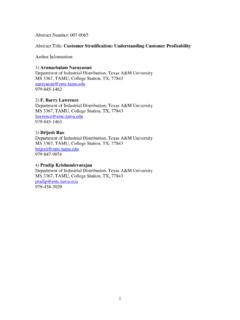Transcription of A Review of Call Center Measurements - POMS
1 A Review of call Center Measurements Stephen J. Willis and michael Bendixen Nova Southeastern University Fort Lauderdale, FL United States of America Abstract The purpose of this paper is to examine the key performance indicators, (KPI s), that call centers or contact centers commonly use to measure performance. It is widely known that call centers typically measure everything and therefore are inundated with mountains of data that measure efficiency rather than performance. This study contrasts historical and current KPI s and what commentary and research indicates exactly what should be the focus of a high performance call Center . The conclusions reached in this paper strongly suggest that call Center performance is IT based meaning that the availability and quality of the infrastructure prohibits the call Center representatives from performing at a high level.
2 A Review of other literature also finds that KPI s from a customer service representative point of view is far different than that of a call Center manager or a higher level executive. This paper finds that there are far more metrics available to assess a call Center performance than primarily efficiency type measures. Background call centers have become an important link in an organization s attempt to communicate with its customers. As call centers expanded their capacity to communicate using tools other than the telephone, (chat, e-mail, interactive voice response), they have now become known as Contact Centers. Growth in call centers are now estimated at 8% per year, (Gans, Koole, & Mandelbaum, 2003) and in western Europe as high as 15%.
3 As the call centers become more and more prevalent, so do the measures of their success. Durr (2001, p192) notes: Managing a contact Center is complicated because the call Center is an invisible world. All that management sees are the agents. Unfortunately, when you inspect a call Center visually, you cannot readily discern a poor Center from an excellent one.) In this invisible world, key performance indicators (KPIs) are typically used to measure the effective use of resources. Miciak and Desmarais (2001) maintain that the majority of measures are operational efficiency measures and have to do with telephone technology in use. This is compounded by typical workforce planning software systems which all tend to measure the same things.
4 These metrics tend to be used because the system routinely produces them and not necessary because each and every one of them is specifically or universally useful. It is almost amusing what these systems can and cannot measure, for instance, average handle time is routinely measured by half hour yet the authors have yet to see a standard deviation for this metric reported. Adherences of employees to the standards of practice (occupancy rates, calls per hour, etc.) are also routinely measured (Gans et , 2003). In this world with a plethora of available measures, it is easy to fall into the trap of using as many of them as possible rather than using them selectively to manage performance.
5 Current Measures The common measures to be found in a call Center (Anton, 1997; Cleveland & Mayben, 1997) are presented in Table 1. Table 1: Common call Center Metrics Measure Typical Shortest Reporting Period Calls offered Half-hourly Calls handled Half-hourly Abandonment rate (%) Half-hourly Calls blocked % Half-hourly Average handle time (AHT) Half-hourly Average speed to answer (ASA) Half-hourly Average queue length Half-hourly Service level (% of calls answered within a specified time) Half-hourly Occupancy (% of time CSRs of busy handling a call ) Half-hourly Adherence to schedule % Half-hourly First call resolution (FCR) Monthly call quality Monthly Staff turnover % Monthly Customer satisfaction Quarterly Marr and Parry (2004, p56)
6 Note that many call Center metrics that appear on walls inside call centers include: 1. Number of calls answered within past ten minutes 2. Calls waiting to be answered, that is in the queue. 3. Number of agents currently taking calls. 4. Number of agents waiting to take calls (free agents). 5. Number of not ready agents. 6. Number of agents on outgoing calls or on a call to another agent. It was also found that customer service representatives (CSRs) typically monitored these performance measures and experienced serious morale problems when the measures were not met. The Influence of Technology Perhaps the main reason that call centers are so intensely scrutinized is that there is a huge investment in technology and human capital.
7 It is estimated from independent studies that 60% of call Center operating costs are attributed to labor (Robinson & Morley, 2006). In a survey that focused on call Center technology (Moreno, 2006), it was revealed that technology frequently interfered with the performance of the CSR. In most cases, the failure of the interactive voice response (IVR) system caused spikes in incoming calls and long queues. In addition, these technology failures also interfered with call durations as they resulted in slow screen pops , inaccurate caller information, and slow or unavailable applications. In effect, the Measurements were not fairly evaluating their CSR s. It is clear that in this age of sophisticated technology that any problems in call Center systems will have an immediate impact on KPI Measurements , call Center productivity and customer quality of service.
8 In the same survey, it was revealed that when there were technology related problems, either the customer or agent were the ones who reported the malfunction. It was interesting to note that only 10% of the respondents reported any quality assurance for their call Center technology (Moreno, 2006). With some industries relying on interactive voice response for nearly 80% of their handled calls it would seem that with a huge investment in this kind of call Center technology that a similar investment in quality assurance would be in order. Services need to be reliable as well as user-friendly (Bennington, Cummane, & Conn, 2000). Generally, customers expect the service to work each and every time and may become angry when there are technological problems.
9 Thus, assessments of service quality will be greatly affected when delays occur. Parasuraman, Berry, and Zeithaml (1988) found that regardless of industry, reliability is the most important contributing factor to service quality. Staff Turnover In addition to the high costs of technology, staff turnover in some call centers is extremely high, with a 50% turnover rate not uncommon. In documented studies, staff turnover is usually within a range of 15 to 35% (Robinson & Morley, 2006). In a study of Fujitsu Services by Marr and Parry, (2004), turnover of front- line call Center staff was found to be 42%. Unlike other organizations, Fujitsu Services realized that they were failing their customer.
10 Many of their contract services were barely meeting service obligations and 15% were at critical levels of dissatisfaction and were likely to seek other service providers (Marr & Perry, 2004). In this study, organizations were faced with the same high costs, quantitative Measurements that seemed to measure performance of the call Center and in most cases, unhappy customers. It would seem that what we make important are those things that we can measure (Feinburg, Kim, Hokama, de Ruyter & Keen, 2000). call Quality and Customer Satisfaction In a study by Ventana Research, (Dawson, 2006), it was concluded that most call centers have not recognized that the best way to reduce cost is to identify why customers are calling and eliminate or reduce the need.










